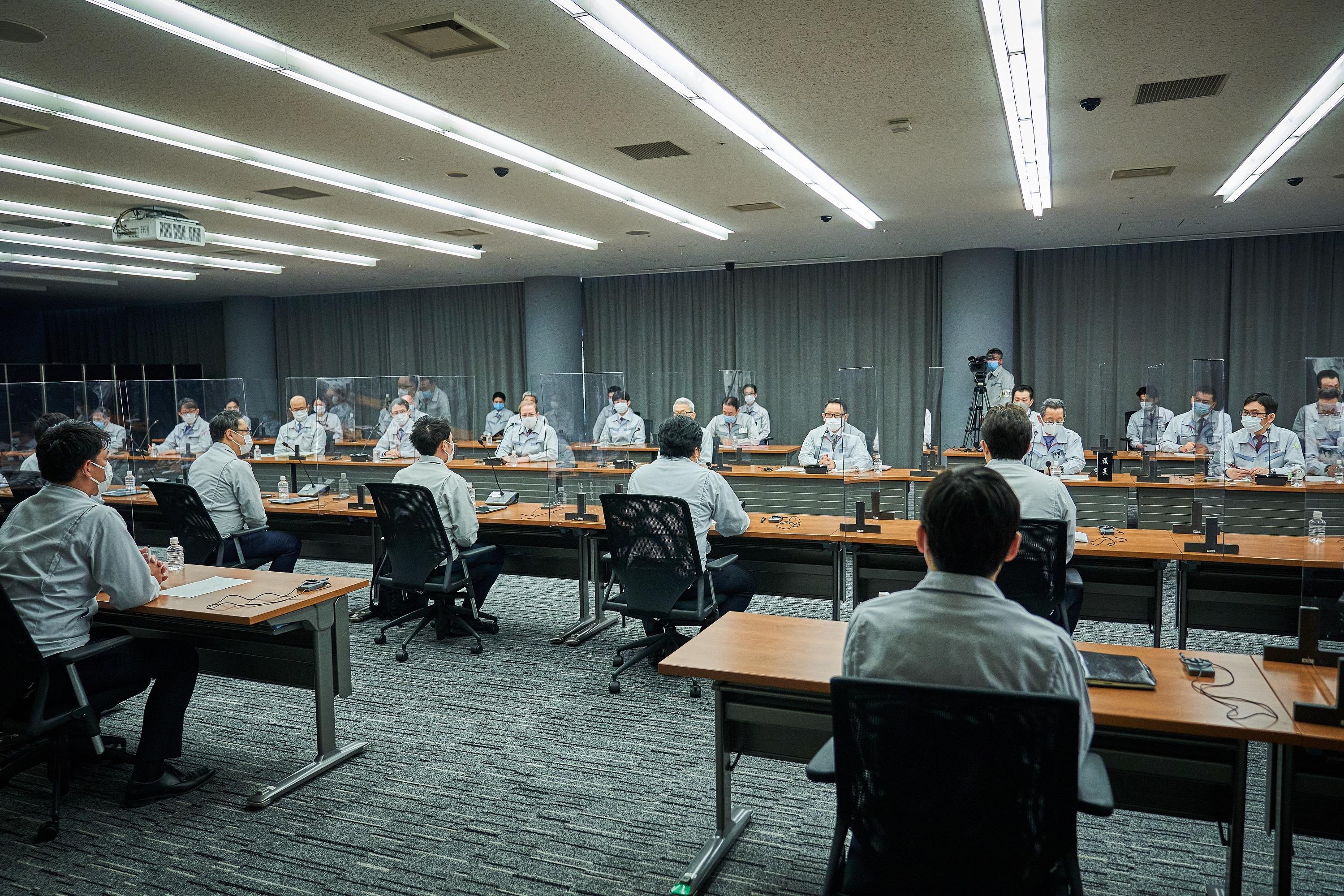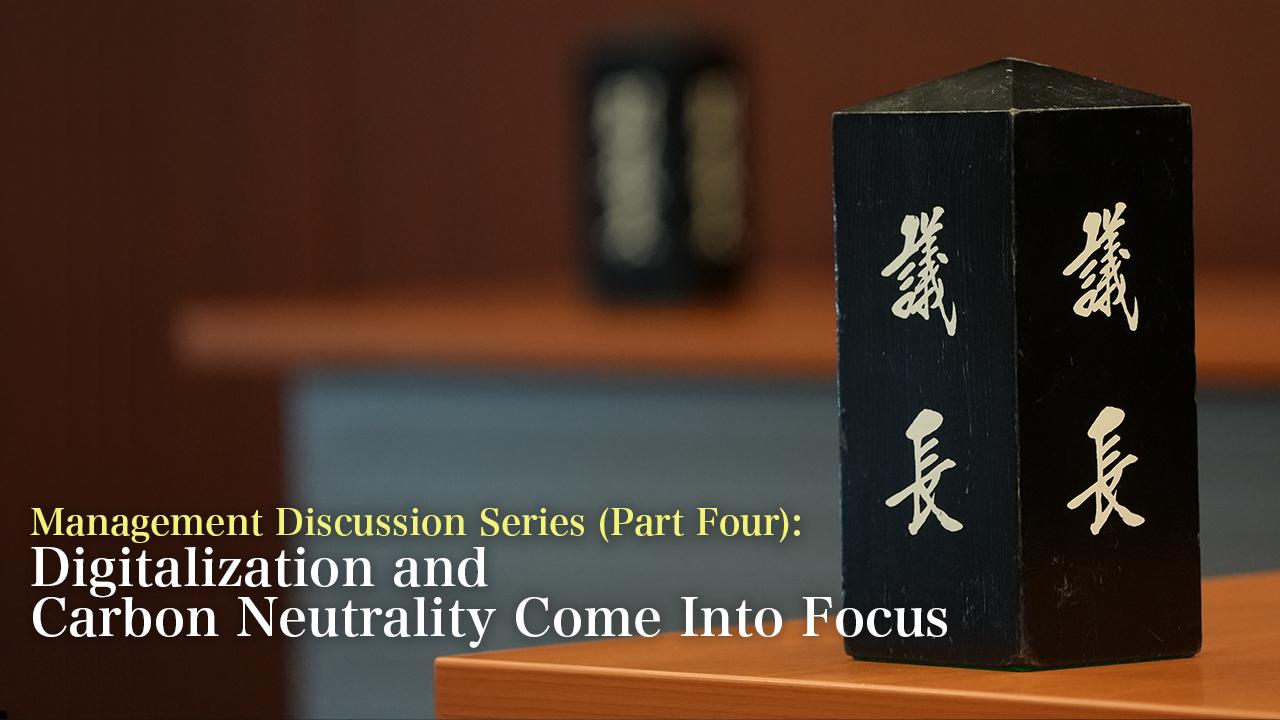
Toyota management details digitalization and carbon neutrality as pillars to focus on to become an industry leader in expanding happiness.

Every spring, TMC hosts discussions between company management and employee representatives. Following an intriguing discussion on the Toyota Production System (TPS), introduced in Part 3, the discussion shifted to the topic of ‘carbon neutrality’.
As is the case in many countries, this topic has become a major theme in Japan, spurring growing debate in both the public and private sectors, after the government’s pledge last autumn to achieve a carbon-neutral society by 2050. Employees asked questions about Toyota’s plans to approach the challenge and what they should focus on as individuals.
Everyone has a role to play in carbon neutrality
The conversation was started by Executive Fellow Shigeki Terashi, who had promoted electrification as the former Chief Technology Officer.
The challenge in carbon neutrality is to elevate the level of cooperation beyond the automobile industry, joining forces with the national government and other industries to reduce CO2 emissions throughout the entire life cycle of a vehicle. Terashi also talked about the ‘three directions’ that should guide Toyota forward.
Executive Fellow Shigeki Terashi
Our society is built on the cycle of making things, transporting what we have made, and using what we have transported, until it is ultimately recycled and disposed of. Carbon neutrality is the concept of reducing the CO2 generated throughout this entire process to zero by 2050.
In the past, BEVs were said to be zero-emission vehicles because they emit no CO2 when driving. However, the method of Life Cycle Assessment counts CO2 at every stage of the process, from production to use and disposal. This means that the CO2 value assigned to a given car differs according to the energy mix of the country where it is made.
Similarly, when we come to work, we turn on machines, equipment, and computers, all of which are connected to the power company. By flipping the switch, CO2 will be emitted from anypower plants that use fossil fuels to produce electricity. The same can be said for natural or propane gas.
People may say that their workplace is emission-free because it uses renewable electricity generated by solar power. However, just like the BEVs I mentioned, CO2 was emitted in the process of making those solar panels.
You may think that your workplace is emission-free because the manufacturing processes are powered by karakuri (hand-made mechanisms that improve work processes) rather than electricity, but even in this case, CO2 is emitted in creating the metals and resins that go into the karakuri, as well as during transport. When you order a part, you are flipping a switch that emits CO2.
The same thing is happening not only at Toyota, but at all parts producers and suppliers.
This is true not only at work but also in the home. What we do in our daily lives, and everything that happens around us 24 hours a day, is a switch that generates CO2.
Prime Minister Suga’s pledge of carbon neutrality means reducing all of these CO2 emissions to net-zero by 2050, in the next 30 years.
You probably have a sense of just how hard that will be.
So what is our role in this? I think there are three directions we should pursue.
1. Energy-saving: Japan is particularly adept at saving energy by making things at low cost with less energy. These are partly what we do with TPS and the results of our cost-reduction initiatives.
2. Technology development: Among many other fields such as CASE and AI, I view hydrogen technology as particularly important for carbon neutrality.3. Building partnerships: This challenge is not something that can be achieved solely through efforts made by the Toyota Group. I think we need to think of it as a grand national, and even global, project that requires the combined efforts of all companies and citizens.
While some may think of the time frame as ‘only’ 30 years, another way of looking at the challenge is to see that we ‘still’ have 30 years to work with. If we look back thirty years ago from today, the Prius or MIRAI had not yet been launched. However, we had already started to develop hybrid and fuel cell technologies.
That is why we now see a movement to collaborate on AI and CASE, and new technologies that may emerge in the future. What we need to do now is properly understand carbon neutrality and join with others in taking action.
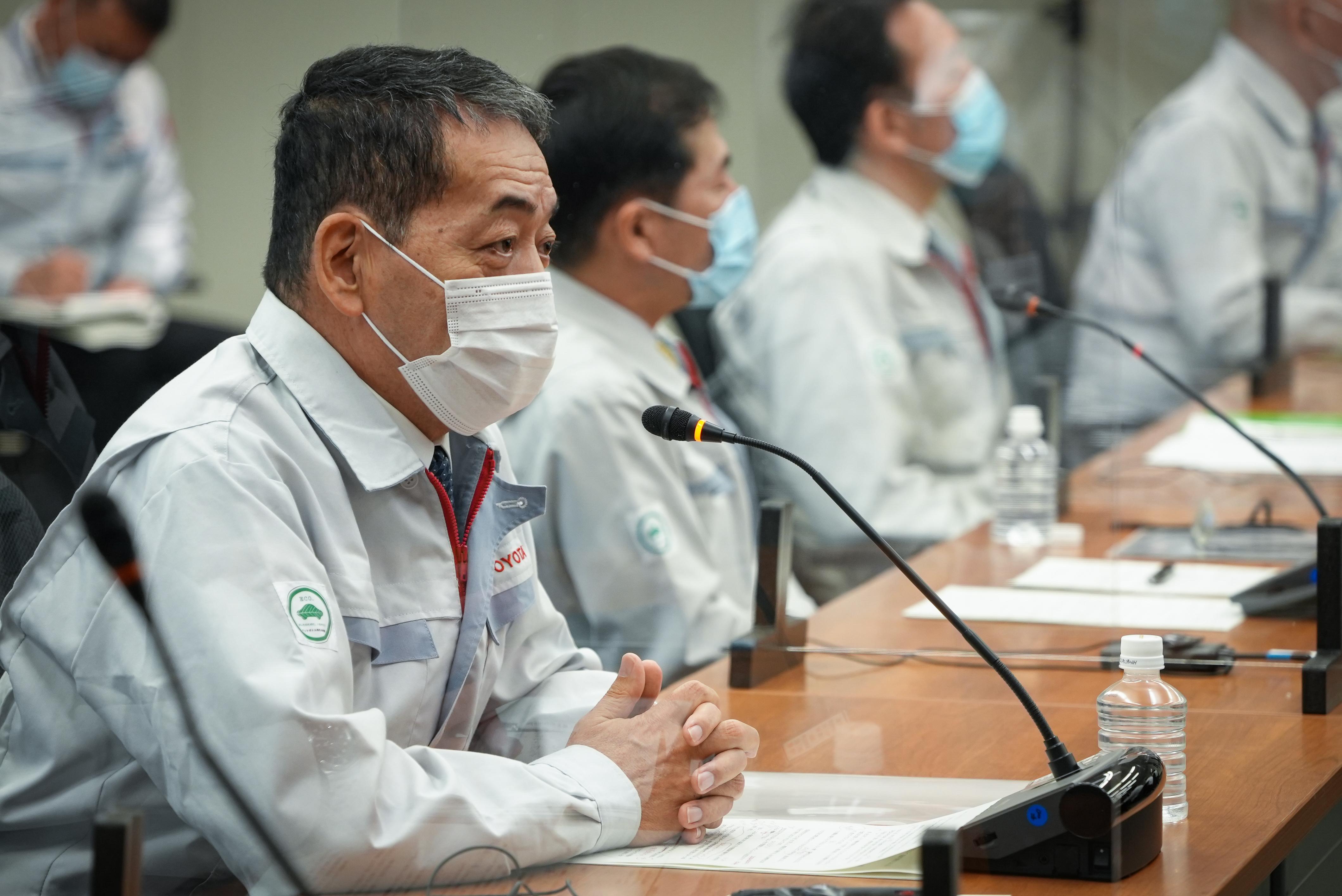
Toyota’s strength lies in driving electrification across all areas
Operating Officer Koji Sato, who serves as president of Lexus International and the GAZOO Racing Company, provided further explanation on ‘Toyota’s strengths in electrification’.
Operating Officer Koji Sato
In the discussion of TPS, we talked about being ‘human-centered’, and the roots of our carbon-neutral initiatives are exactly the same. I think we need to consider this challenge from a human-centered ‘you’ perspective.
This so-called “you” perspective involves considering the impact of our car production on the economy and energy environment, something that cannot be solved by car companies simply making cars.
We have to tackle this challenge with collective action across the entire automobile industry. We also need to take into account how the energy situation differs by region, within a single country or across the world.
Most importantly, we must not forget the principle that the customer is the one that chooses the product.
Even in Europe, where BEVs are rapidly gaining market penetration, the HEV Yaris has been very well received. I feel that we need to base our car-making decisions on a proper understanding of the world around us.
Rather than focusing excessively on BEVs, I think that Toyota should ensure that we provide a wide range of electrified powertrain solutions, including HEVs, PHEVs, and BEVs.
The data shown here compares CO2 emissions over the life cycle of each powertrain.
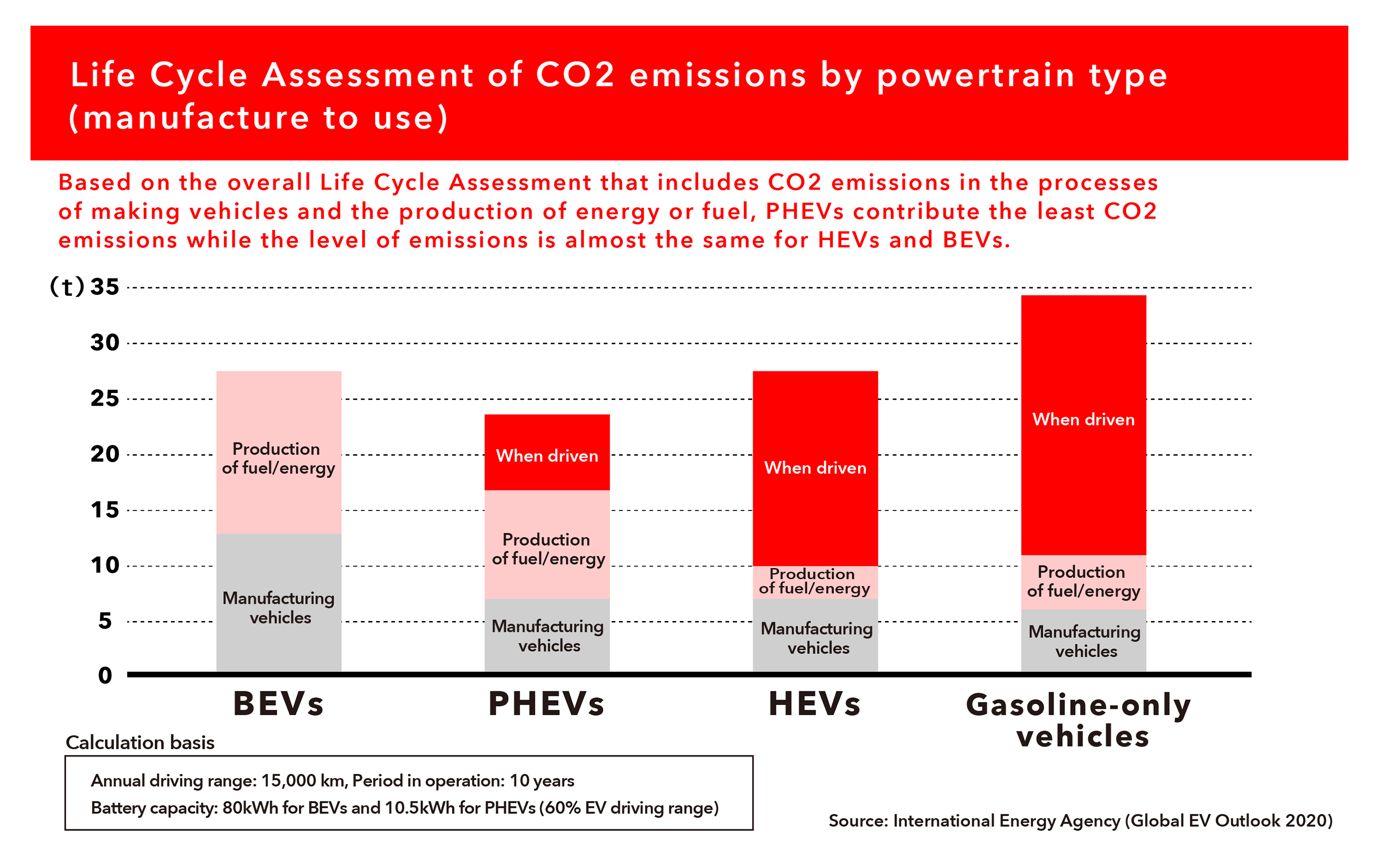
When we consider the entire life cycle, PHEVs actually have lower CO2 emissions than BEVs.
Looking at realistic solutions based on this situation, I think for the time being it continues to be important to focus on HEVs, which have been proven to greatly reduce CO2, as a starting point for working towards the major goal of carbon neutrality.
Similarly, when you consider the state of infrastructure, I think our role is to spread the advantages of HEVs and PHEVs, which allow the additional on-board battery to recharge while driving, in order to begin moving toward carbon neutrality as soon as possible.
I think we need to make use of Toyota’s hard-won strengths in HEVs to address immediate issues (in the short term), while preparing to make our utmost effort in BEVs once market and customer needs are properly established, as well as to move into the era of hydrogen (in the mid-to-long term).
Until now, our approach with HEVs has been to extract power by prioritizing engine efficiency, while remaining conscious of fuel efficiency. Even with the same hardware, I believe we have the potential to optimize/further improve our HEVs for future electrification by innovating in the area of software controls.
We face various challenges on the road to carbon neutrality. Even if BEVs do become the majority, car companies cannot control how much time the process takes. We must keep pace alongside our many peers.
When the time comes, our strength will lie in the fact that we already possess an outstanding range of platforms through TNGA.
Armed with TNGA platforms capable of accommodating HEVs, we can convert these to create BEVs as required.
In doing so, we can adopt a strategy that features a mix of BEV, HEV, and PHEV variants within the same model.
While working to avoid the commoditization of electric vehicles, I hope we can use our strengths as a car company to create a mobility society that offers people hope for the future.
Two pillars that will underpin Toyota’s activities in the next three years
Nearing the end of the discussion, Operating Officer Masanori Kuwata presented two pillars that Toyota should keenly focus on moving forward.
Operating Officer Masanori Kuwata
In our first discussion, President Toyoda spoke about how the automobile industry has been ‘working together’, highlighting the importance of mutually beneficial relationships in an industry where everyone ‘finds a way to come together’. These discussions have brought that point home.
Our base remains the same as always: contributing to our partners in the automobile industry by continuing to make ever-better cars.
To that end, we must tackle digitalization and, as discussed today, carbon neutrality.
In this era of once-in-a-century transformation, these are goals that can only be attained if everyone in the automobile industry works together.
If we are able to lead the automotive industry in digitalization and carbon neutrality, Toyota may become a presence for which our many peers may be thankful for.
By bringing our many peers together, we can also make their work easier and more enjoyable.
As a result, I believe we would be one step closer to fulfilling the commitment set out in the SDGs, to ‘leave no one behind’.
For these reasons, we have positioned digitalization and carbon neutrality as the ‘two pillars’ that we will strive to establish over the next three-year period.
I hope that this discussion will serve as a starting point for earnest action in these two areas.
Continuing on from the third session which focused on TPS and carbon neutrality, the year’s final discussion was held the following week. There, President Akio Toyoda summarized the previous conversations.
World-class digitalization in three years
In response to the current situation of TMC's digitalization, Akio declared his commitment to making rapid advances in this area in the next three years.
Akio
As mentioned in our discussions, digitalization and carbon neutrality will be the ‘two pillars’ which we will all work to establish. Please allow me to now share my thoughts on these points.
First, in terms of digitalization, over the next three years I want to bring us up to the level of the world’s top companies.
Even now, there is a tendency at Toyota to look up to the people who have information, and the reality is that information rests in the hands of a limited few, without being shared.
In this once-in-a-century period of profound transformation, where we are fighting for our very survival, this is a critical state of affairs that should be addressed.
Applying the concepts of TPS (Toyota Production System), I think it is important that the necessary amount of information is available to those who need it, when they need it.
Through our digitalization drive, I hope to eliminate the information gap and improve the current environment so that not just Toyota, but everyone in the automobile industry, can focus on moving in the same direction.
Becoming an industry leader in expanding happiness
Next, Akio spoke about his desire to lead the automobile industry in the two pillars of digitalization and carbon neutrality.
Akio
At the moment, I believe that Toyota is being looked at to serve as a leader in one particular area – the happiness of the entire automotive industry.
If Toyota's team is able to serve as an automobile industry leader in the two pillars of digitalization and carbon neutrality, we may become a presence for which our industry peers will be thankful for.
Working towards our three-year goals, I hope that these discussions will serve as a starting point for rapid progress in these two pillars.
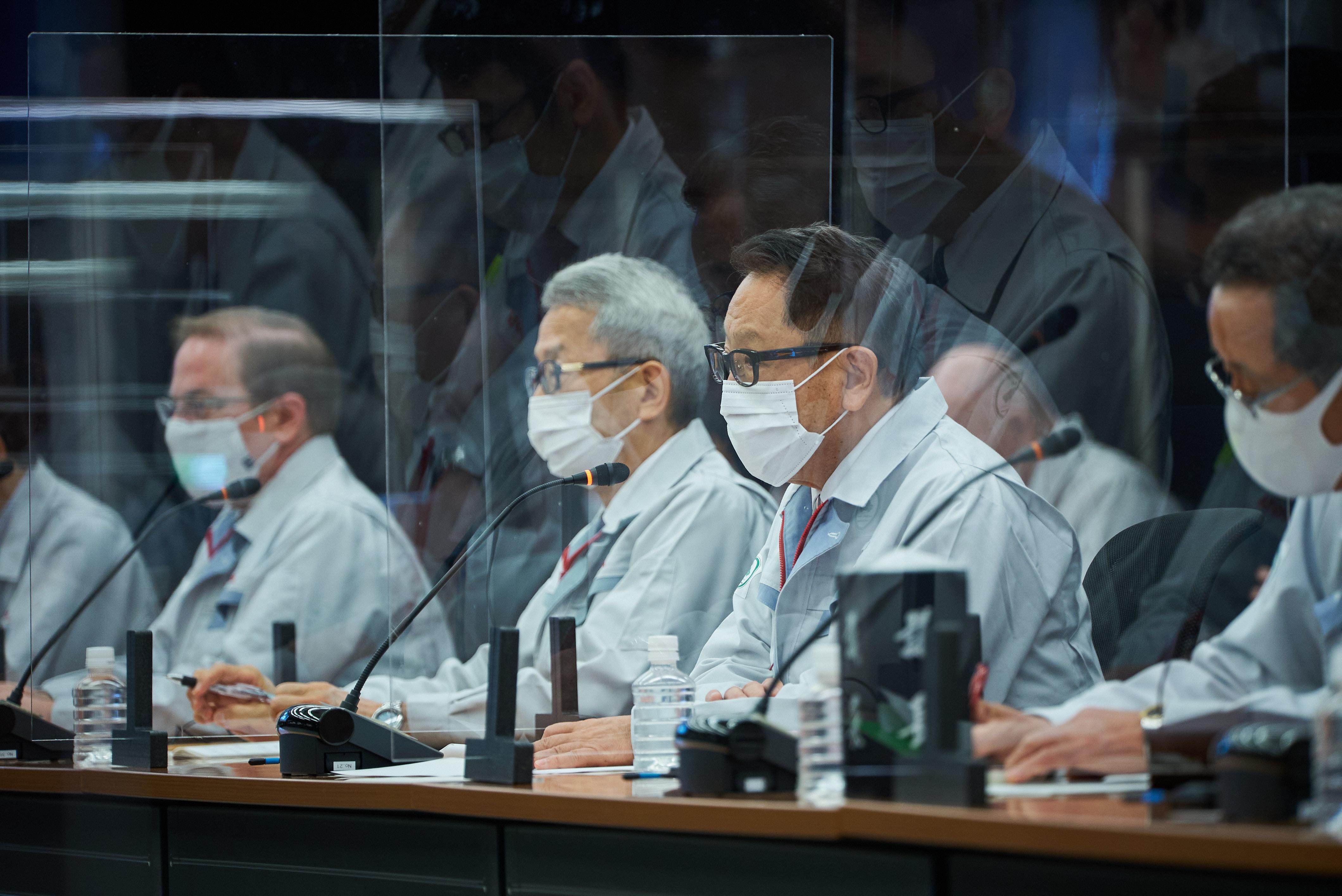
10 years from now: either things run their natural course or we fight for a different, better future
Finally, Akio spoke about the importance of moving forward with determination over the next ten years.
Akio
Ten years ago, in the wake of the Great East Japan Earthquake, we found ourselves desperately fighting to keep Japanese manufacturing alive. We didn’t even consider the possibility that, a decade later, Japan's manufacturing industry would be facing an even more arduous challenge.
What will the situation be like for Toyota, and Japan, in March 2031, ten years from now?
Will Phase 2 of Woven City be completed around that time? How much progress will have been made in hydrogen and other green energies, and what will the mix of electrified vehicles look like?
To me, there is a world of difference between simply letting things run the course for the next decade, and how it might look next decade if we are continuing to fight resolutely.
If everyone at Toyota remains committed to working ‘for our partners in the automobile industry’, ‘for society’, and ‘for the children of the future’ – if we continue to fulfill our role with that mindset – I am sure the results will be very different.
Let us move forward as one, step by step, with our hearts and minds united, in the belief that what awaits us is the world set out in the ‘18th SDG’, wherein I would add one more to the existing 17 goals– a goal for a mobility society that offers happiness for all.
Through the discussions described in this four-part series, Toyota has arrived at the starting point of building the future of the automobile industry together with its many partners, based on the two pillars of digitalization and carbon neutrality. Please stay tuned moving forward as Toyota Times intends to continue to watch those efforts closely.
